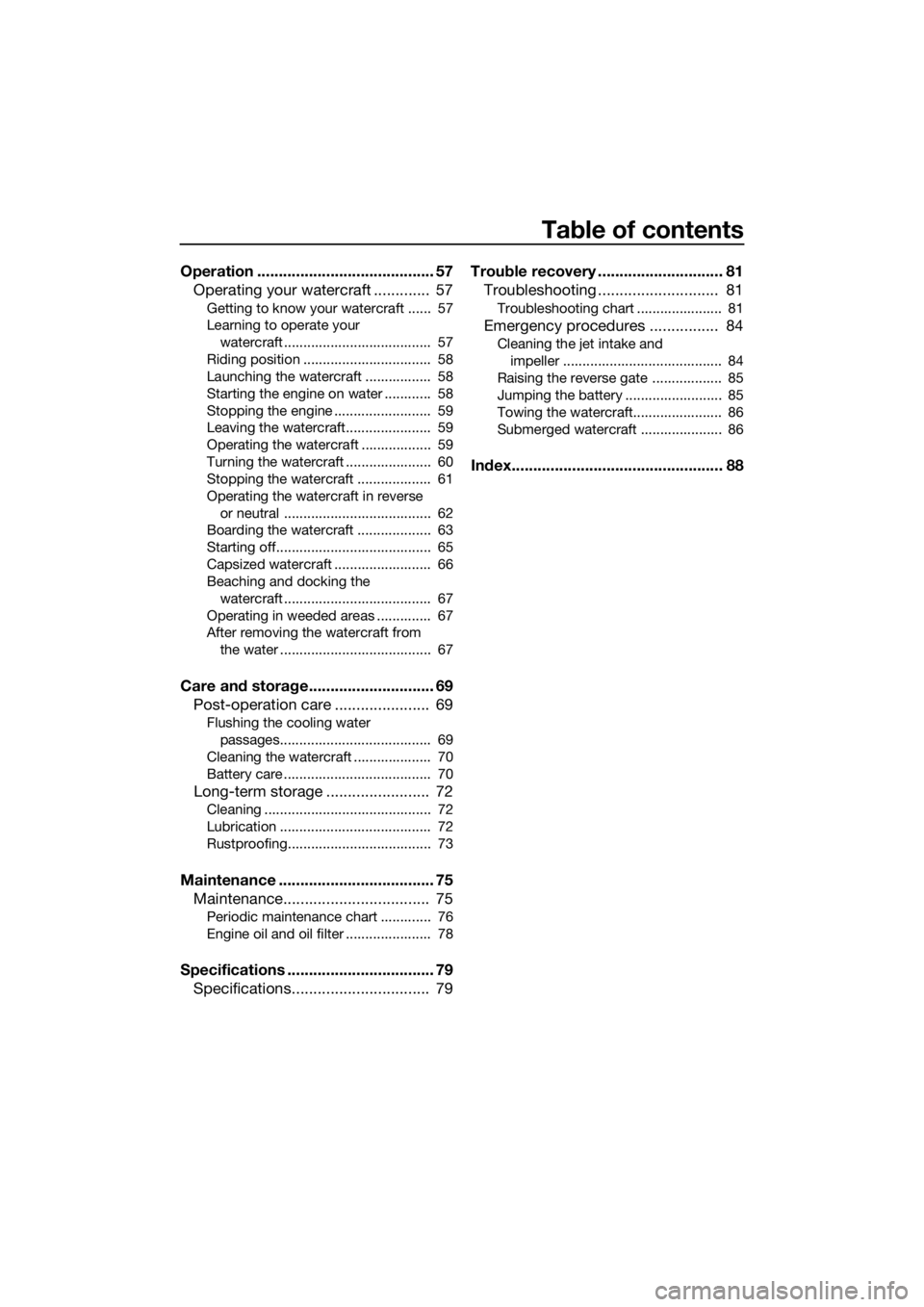stop start YAMAHA JETBLASTER 2022 Owners Manual
[x] Cancel search | Manufacturer: YAMAHA, Model Year: 2022, Model line: JETBLASTER, Model: YAMAHA JETBLASTER 2022Pages: 98, PDF Size: 4.83 MB
Page 6 of 98

Table of contents
General and important labels ........... 1Identification numbers .................... 1
Primary Identification (PRI-ID)
number............................................ 1
Craft Identification Number (CIN) ....... 1
Engine serial number.......................... 1
Manufactured date label .................... 2
Model information ........................... 2
Builder’s plate .................................... 2
Important labels .............................. 4
Warning labels.................................... 5
Other labels ........................................ 8
Safety information ............................. 9 Limitations on who may operate the watercraft ............................... 9
Cruising limitations ........................ 10
Operation requirements ................ 11
Recommended equipment ........... 13
Hazard information........................ 14
Watercraft characteristics ............. 14
Wakeboarding and water-skiing ... 16
Safe boating rules ......................... 17
Enjoy your watercraft responsibly ................................. 18
Description....................................... 19 Watercraft glossary ....................... 19
Location of main components ...... 20
Control function operation ............. 24 Watercraft control functions ......... 24
Engine start/stop switch ................. 24
Engine shut-off switch .................... 24
Throttle lever .................................... 24
RiDE lever ........................................ 25
Steering system ............................... 25
Cooling water pilot outlet ................. 25
Water separator................................ 26
Watercraft operation ...................... 27Watercraft operation functions ..... 27
Shift system ..................................... 27
Electric trim system .......................... 29
Instrument operation ...................... 31Multifunction information center ... 31
Information display ........................... 31
Equipment operation ...................... 36Equipment..................................... 36
Seat .................................................. 36
Handgrip........................................... 36
Reboarding grip................................ 37
Reboarding step ............................... 37
Foot chocks...................................... 37
Bow eye............................................ 38
Stern eyes ........................................ 38
Cleat ................................................. 38
Storage compartments .................... 38
Fire extinguisher holder .................... 40
Operation and handling
requirements ................................... 41Fuel requirements ......................... 41
Fuel................................................... 41
Engine oil requirements ................ 43
Engine oil .......................................... 43
Draining the bilge water ................ 45
Draining the bilge water on land....... 45
Draining the bilge water on water .... 45
Transporting on a trailer................ 46
First-time operation ........................ 47 Engine break-in............................. 47
Pre-operation checks ..................... 48
Pre-operation checklist .................... 48
Pre-operation check points .......... 50
Pre-launch checks ........................... 50
Post-launch checks.......................... 55
UF6C70E0.book Page 1 Wednesday, November 10, 2021 11:33 AM
Page 7 of 98

Table of contents
Operation ......................................... 57Operating your watercraft ............. 57
Getting to know your watercraft ...... 57
Learning to operate your
watercraft ...................................... 57
Riding position ................................. 58
Launching the watercraft ................. 58
Starting the engine on water ............ 58
Stopping the engine ......................... 59
Leaving the watercraft...................... 59
Operating the watercraft .................. 59
Turning the watercraft ...................... 60
Stopping the watercraft ................... 61
Operating the watercraft in reverse or neutral ...................................... 62
Boarding the watercraft ................... 63
Starting off........................................ 65
Capsized watercraft ......................... 66
Beaching and docking the
watercraft ...................................... 67
Operating in weeded areas .............. 67
After removing the watercraft from the water ....................................... 67
Care and storage............................. 69Post-operation care ...................... 69
Flushing the cooling water
passages....................................... 69
Cleaning the watercraft .................... 70
Battery care ...................................... 70
Long-term storage ........................ 72
Cleaning ........................................... 72
Lubrication ....................................... 72
Rustproofing..................................... 73
Maintenance .................................... 75 Maintenance.................................. 75
Periodic maintenance chart ............. 76
Engine oil and oil filter ...................... 78
Specifications .................................. 79Specifications................................ 79 Trouble recovery ............................. 81
Troubleshooting ............................ 81
Troubleshooting chart ...................... 81
Emergency procedures ................ 84
Cleaning the jet intake and
impeller ......................................... 84
Raising the reverse gate .................. 85
Jumping the battery ......................... 85
Towing the watercraft....................... 86
Submerged watercraft ..................... 86
Index................................................. 88
UF6C70E0.book Page 2 Wednesday, November 10, 2021 11:33 AM
Page 19 of 98

Safety information
12
in certain kinds of accidents and that it
could injure you in others.
A helmet is designed to provide some head
protection. Although helmets cannot pro-
tect against all foreseeable impacts, a hel-
met might reduce your injuries in a collision
with a boat or other obstacle.
A helmet may have potential safety haz-
ards, as well. Falling into the water could
risk the chance of the helmet catching wa-
ter, commonly known as “bucketing”, and
the resulting strain on your neck could cau-
se choking, severe and permanent neck in-
juries, or death. A helmet could also
increase the risk of an accident if it reduces
your vision or hearing, or if it distracts you
or increases your fatigue.
How should you decide if a helmet’s poten-
tial safety benefits outweigh its potential
risks for you? Consider your particular rid-
ing conditions. Consider factors such as
your riding environment and your riding
style and ability. Also consider the likeli-
hood of traffic congestion, and the water
surface conditions.
If you decide to wear a helmet based upon
your riding circumstances, choose one
carefully. Look for a helmet designed for
personal watercraft use, if possible. If you
will be engaging in closed-course competi-
tion, follow the helmet requirements of the
sanctioning organization.
Never operate the watercraft after consum-
ing alcohol or taking other drugs.
For reasons of safety and proper care of
the watercraft, always perform the pre-op-
eration checks listed on page 48 before op-
erating the watercraft.
The operator should grip the handlebars
firmly with both hands and the passengers
should hold on firmly, either to the person in front of them or to the handgrip provid-
ed.
The operator and passengers should al-
ways keep their feet on the floor of the foot-
well when the watercraft is in motion.
Lifting your feet increases the chances of
losing your balance,
or hitting objects out-
side the watercraft with your feet. Do not
give a ride to children if their feet cannot
reach the floor of the footwell.
Never allow a passenger to ride in front of
the operator.
Always consult your doctor on whether it is
safe for you to ride this watercraft if you are
pregnant or in poor health.
Do not attempt to modify this watercraft.
Modifications to your watercraft may re-
duce safety and reliability, and render the
watercraft unsafe or illegal for use.
Attach the engine shut-off cord (lanyard) to
y o u r l ef t w r is t an d k ee p i t fr e e f r o m t h e h an -
dlebars so that the engine stops if you, the
operator, fall off. After riding, remove the
engine shut-off cord (lanyard) from the wa-
tercraft to avoid accidental starting or un-
authorized use by children or others.
UF6C70E0.book Page 12 Wednesday, November 10, 2021 11:33 AM
Page 29 of 98

Description
22
69
10
6
1
2
3
4
58 7
1
RiDE lever (page 27)
2 Engine shut-off switch (page 24)
3 Clip (page 24)
4 “TRIM” switch (page 29)
5 Engine shut-off cord (lanyard) (page 24)
6 Rearview mirror
7 Throttle lever (page 24)
8 Engine start/stop switch (page 24)
9 Multifunction information center (page 31)
10 Glove compartment (page 39)
UF6C70E0.book Page 22 Wednesday, November 10, 2021 11:33 AM
Page 31 of 98

Control function operation
24
EJU31027
Watercraft control functionsEJU47111Engine start/stop switch “ / ”ECJ01311
Do not run the engine over 4000 r/min on
land. Also, do not run the engine for more
than 15 seconds without supplying water,
otherwise the engine could overheat.
The engine start/stop switch (red button)
starts the engine when the switch is pushed
while the engine is stopped, and stops the
engine when the switch is pushed while the
engine is running.
Release the engine start/stop switch as soon
as the engine starts to run. If the engine does
not start in 5 seconds, release the engine
start/stop switch, wait 15 seconds, and then
try again.
The engine will not start under any of the fol-
lowing conditions:
Clip is removed from the engine shut-off
switch.
Throttle lever is squeezed.
Throttle lever is malfunctioning.
RiDE lever is squeezed.
RiDE lever is malfunctioning.
EJU31164Engine shut-off switch “ ”
The engine shut-off switch automatically
stops the engine when the clip, on the end of
the engine shut-off cord (lanyard), is removed
from the switch, such as if the operator falls
off the watercraft.
Insert the clip under the engine shut-off
switch before starting the engine.
When the engine is not running, remove the
clip from the engine shut-off switch to pre-
vent accidental starting or unauthorized op-
eration by children or others.
EJU31212Throttle lever
The throttle lever increases the engine speed
when the lever is squeezed.
1Engine start/stop switch
1
1Engine shut-off switch
2 Clip
3 Engine shut-off cord (lanyard)
1
2
3
UF6C70E0.book Page 24 Wednesday, November 10, 2021 11:33 AM
Page 32 of 98

Control function operation
25
The throttle lever returns automatically to its
fully closed (idle) position when released.
EJU43343RiDE lever
When the RiDE lever is squeezed, the reverse
gate lowers and the watercraft starts moving
in reverse. If the watercraft is moving forward,
the watercraft gradually slows down until it
stops, and then the watercraft starts moving
in reverse.
When the RiDE lever is released, it automati-
cally returns to its fully closed (idle) position
and the reverse gate moves to the neutral po-
sition.
EJU31263Steering system
By turning the handlebars in the direction you
wish to travel, the angle of the jet thrust noz-
zle is changed, and the direction of the water-
craft is changed accordingly.Since the strength of the jet thrust determines
the speed and degree of a turn, throttle must
always be applied when attempting a turn,
except at trolling speed.
This model is equipped with the Yamaha En-
gine Management System (YEMS) that in-
cludes an off-throttle steering (OTS) system.
It will activate at planing speeds should you
attempt to steer the watercraft after releasing
the throttle lever. The OTS system assists in
turning by continuing to supply some thrust
while the watercraft is decelerating, but you
can turn more sharply if you apply throttle
while turning the handlebars. The OTS sys-
tem does not function below planing speeds
or when the engine is off. Once the engine
slows down, the watercraft will no longer turn
in response to handlebar input until you apply
throttle again or you reach trolling speed.EJU35975Cooling water pilot outlet
When the engine is running, some of the
cooling water that is circulated in the engine
1
Throttle lever
1 RiDE lever
1
1
1Handlebar
2 Jet thrust nozzle
1
2
UF6C70E0.book Page 25 Wednesday, November 10, 2021 11:33 AM
Page 33 of 98

Control function operation
26
is discharged from the cooling water pilot
outlet.
There is a cooling water pilot outlet on the
port (left) side of the watercraft. To check for
proper operation of the cooling system, make
sure that water is being discharged from the
cooling water pilot outlet. If water is not being
discharged from the outlet, stop the engine
and check the jet intake for clogging. (See
page 84 for information on the jet intake.)
TIP
It will take about 60 seconds for the water
to reach the outlet after the engine is start-
ed.
Water discharge may not be constant
when the engine is running at idling speed.
If this occurs, apply a little throttle to make
sure that water discharges properly.
EJU40323Water separator
The water separator prevents water from en-
tering the fuel tank by collecting any water
that has entered the fuel tank breather hose if
the watercraft was capsized.
If water has collected in the water separator,
drain it by loosening the drain screw.
To drain water from the water separator:
(1) Place a drain pan or dry cloth under thewater separator.
(2) Gradually loosen the drain screw to drain the water. Catch the draining water in the
drain pan or soak it up with the dry cloth
so that it does not spill into the engine
compartment. If any water spills into the
watercraft, be sure to wipe it up with a
dry cloth.
(3) Securely tighten the drain screw until it stops.
1Cooling water pilot outlet
11Water separator
2 Drain screw
2
1
UF6C70E0.book Page 26 Wednesday, November 10, 2021 11:33 AM
Page 38 of 98

Instrument operation
31
EJU47200
Multifunction information center
The multifunction information center displays
various watercraft information.
Multifunction information center initial op-
eration
When the multifunction information center is
activated, all of the display segments come
on. After 2 seconds, the warning indicators in
the information display go off, and then the
center starts to operate normally.
TIP
The multifunction information center is turned
on, even if the engine start/stop switch is also
pushed briefly.
Multifunction information center standby
state
If the multifunction information center does
not receive any operation input within 30 sec-
onds after the engine stops, the center will
turn off and enter a standby state. When the
engine is started again, the displays return to
their state before the center turned off, and
then the center starts to operate normally.
EJU35028Information display
The information display shows watercraft op-
erating conditions.
EJU47131Speedometer
The speedometer shows the watercraft
speed.
By switching the display units, the speed can
be shown in kilometers per hour “km/h” or
miles per hour “MPH”.
TIP
“MPH” is selected as the display unit at the
Yamaha factory.
1 Information display
2 “WARNING” indicator light
21
1Trim indicator
2 Shift indicator
3 Engine overheat warning indicator
4 Check engine warning indicator
5 Oil pressure warning indicator
6 Tachometer / hour meter / voltmeter
7 Fuel level meter
8 Fuel indicator
9 Speedometer
1 Speedometer
2345716
98
1
UF6C70E0.book Page 31 Wednesday, November 10, 2021 11:33 AM
Page 39 of 98

Instrument operation
32
To switch the speedometer display
units:
Start the engine, stop the engine, and then
remove and insert the clip 3 times before the
multifunction information center turns off.
The speedometer display units change.
To switch the speedometer display units
again, repeat this procedure.
EJU44650Tachometer
The tachometer shows the engine speed.
TIP
While the engine is stopped, the battery volt-
age and the total engine hours are displayed
alternately.
EJU43891Shift indicator
This indicator shows the reverse gate shift
positions: “F” (forward), “N” (neutral), and “R”
(reverse). (See page 27 for shifting proce-
dures.)
EJU47181Trim indicator
This indicator shows the trim angle of the jet
thrust nozzle. When the neutral position of
the jet thrust nozzle is selected, the trim indi-
cator shows the segment next to the trim
icon. Increasing the trim angle will show the
1Clip
2 Engine shut-off switch
1 Speedometer
1
2
1
1Tachometer
1 Shift indicator
2 “F” (Forward position)
3 “N” (Neutral position)
4 “R” (Reverse position)
1
1
2
3
4
UF6C70E0.book Page 32 Wednesday, November 10, 2021 11:33 AM
Page 41 of 98

Instrument operation
34
EJU37272Fuel level meter
The fuel level meter shows the amount of fuel
remaining in the fuel tank. The amount of re-
maining fuel is shown using four display seg-
ments, which disappear one at a time as the
fuel level decreases.
TIP
The accuracy of the fuel level meter varies
depending on the operating conditions. Use
this function as a reference only.
EJU44711Fuel level warning
If the fuel remaining in the fuel tank drops to
about 8 L (2.1 US gal, 1.8 Imp.gal), the lowest
fuel level segment, the fuel level warning indi-
cator, and the “WARNING” indicator light
blink, and the buzzer sounds intermittently for
30 seconds.If the fuel level warning is activated, refill the
fuel tank as soon as possible. (See page 41
for information on filling the fuel tank.)
After the fuel tank is refilled, the warning sig-
nals will be cleared when the engine is re-
started.
EJU43721Oil pressure warning
If the oil pressure drops significantly, the oil
pressure warning indicator, the check engine
warning indicator, and the “WARNING” indi-
cator light blink, and the buzzer sounds inter-
mittently for 30 seconds. At the same time,
the maximum engine speed is limited.
If the oil pressure warning is activated, imme-
diately reduce the engine speed, return to
shore, and then check the engine oil level.
(See page 43 for information on checking the
engine oil level.) If the oil level is sufficient,
have a Yamaha dealer check the watercraft.
EJU43902Engine overheat warning
If the engine temperature rises significantly,
the engine overheat warning indicator, the
check engine warning indicator, and the
“WARNING” indicator light blink, and the
buzzer sounds intermittently. After 5 sec-
onds, the engine overheat warning indicator
and the “WARNING” indicator light stop
blinking and remain on, and the buzzer
sounds continuously. After 30 seconds, the
buzzer stops. While the engine overheat
1
Fuel level meter
1
UF6C70E0.book Page 34 Wednesday, November 10, 2021 11:33 AM